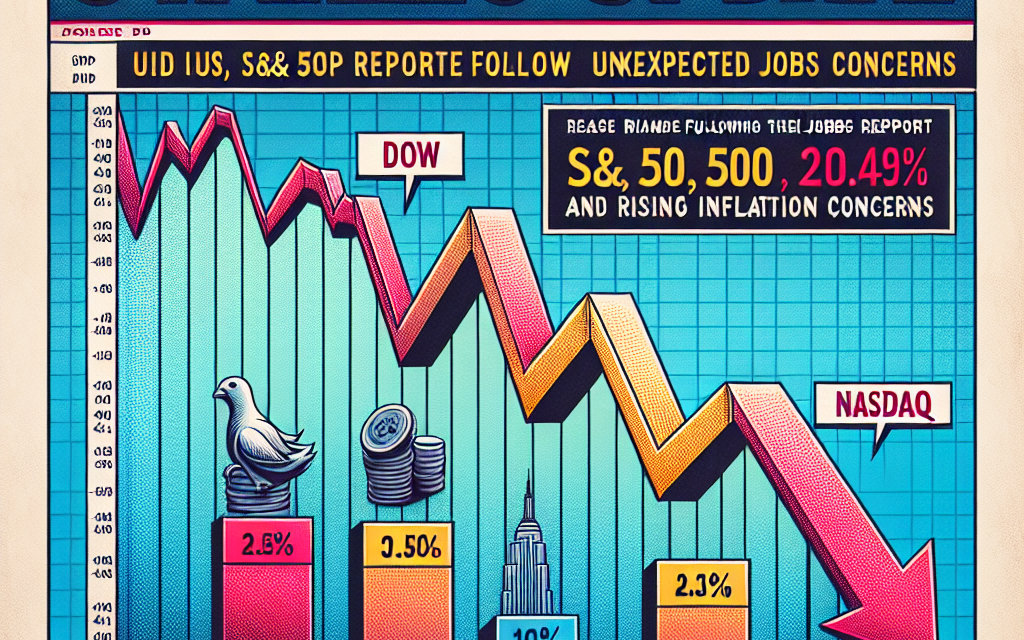“Market Meltdown: Dow, S&P 500, and Nasdaq Dip Amid Surprising Jobs Data and Inflation Worries.”
Introduction
In today’s stock market update, major indices including the Dow Jones Industrial Average, S&P 500, and Nasdaq experienced declines following the release of an unexpected jobs report that raised concerns about the economy. The report indicated stronger-than-anticipated job growth, which, while positive on the surface, has led to fears of rising inflation and potential interest rate hikes by the Federal Reserve. Investors reacted by pulling back from equities, reflecting uncertainty about the economic outlook and the implications for monetary policy. As market participants digest these developments, volatility is expected to persist in the coming days.
Dow Jones Reaction to Jobs Report
In the wake of the latest jobs report, the Dow Jones Industrial Average experienced a notable decline, reflecting investor concerns over the implications of the data on the broader economy. The report, which revealed a stronger-than-expected increase in job creation, initially seemed to suggest a robust labor market. However, as analysts delved deeper into the figures, it became evident that the accompanying rise in wages and persistent inflationary pressures were causing unease among market participants. This duality of a strong job market coupled with inflationary concerns led to a reevaluation of economic conditions, prompting a sell-off in equities.
As the trading day progressed, the Dow’s reaction became increasingly pronounced. Investors, wary of the Federal Reserve’s potential response to the inflationary signals, began to adjust their portfolios in anticipation of tighter monetary policy. The prospect of rising interest rates, which could dampen economic growth, weighed heavily on market sentiment. Consequently, the Dow, along with other major indices, faced downward pressure as traders sought to mitigate risk in an uncertain environment.
Moreover, the market’s reaction was not solely confined to the immediate aftermath of the jobs report. The broader implications of sustained inflation and a tightening labor market raised questions about the sustainability of economic growth. As wages rise, businesses may face increased costs, which could lead to higher prices for consumers. This potential scenario further complicates the economic landscape, as it could prompt the Federal Reserve to act more aggressively in its monetary policy, thereby impacting corporate earnings and overall market performance.
In addition to these macroeconomic factors, sector-specific dynamics also played a role in the Dow’s decline. Industries that are particularly sensitive to interest rate changes, such as utilities and real estate, saw significant sell-offs as investors recalibrated their expectations. Conversely, sectors that typically benefit from rising rates, such as financials, did not provide sufficient support to offset the broader market weakness. This divergence highlighted the complexity of the current economic environment, where traditional correlations between sectors may no longer hold true.
Furthermore, the volatility in the stock market was exacerbated by geopolitical tensions and ongoing supply chain disruptions, which have continued to plague the global economy. These external factors added another layer of uncertainty, prompting investors to adopt a more cautious approach. As the Dow and other indices grappled with these challenges, the overall market sentiment shifted towards risk aversion, leading to a broader sell-off across various asset classes.
In conclusion, the Dow Jones Industrial Average’s reaction to the unexpected jobs report underscores the intricate interplay between labor market dynamics and inflationary pressures. As investors navigate this complex landscape, the implications of rising wages and potential Federal Reserve actions loom large. The market’s response reflects a growing awareness of the challenges ahead, as participants weigh the prospects of economic growth against the backdrop of tightening monetary policy. As the situation evolves, market observers will be keenly watching for further developments that could influence the trajectory of the Dow and the broader stock market.
S&P 500 Trends Amid Inflation Worries
In recent weeks, the S&P 500 has experienced notable fluctuations, primarily driven by rising inflation concerns and an unexpected jobs report that has left investors apprehensive about the economic outlook. As inflationary pressures continue to mount, the index, which is a benchmark for the performance of large-cap U.S. equities, has faced significant headwinds. The latest jobs report revealed a stronger-than-anticipated increase in employment, which, while generally a positive sign for the economy, has raised alarms about the potential for the Federal Reserve to adopt a more aggressive stance on interest rates. This duality of good news and bad news has created a complex environment for investors, leading to increased volatility in the S&P 500.
As inflation rates climb, the purchasing power of consumers is eroded, prompting concerns about consumer spending, which is a critical driver of economic growth. The S&P 500, being heavily influenced by consumer-related sectors, has felt the impact of these inflationary trends. Companies within the index are grappling with rising costs for raw materials and labor, which could ultimately squeeze profit margins. Consequently, investors are closely monitoring corporate earnings reports to gauge how well companies are managing these challenges. The anticipation surrounding these earnings releases has contributed to the overall uncertainty in the market, as traders weigh the potential for disappointing results against the backdrop of persistent inflation.
Moreover, the Federal Reserve’s monetary policy decisions are at the forefront of investors’ minds. With inflation consistently exceeding the central bank’s target, there is growing speculation that the Fed may need to implement further rate hikes to rein in price increases. Such actions could have a cascading effect on the S&P 500, as higher interest rates typically lead to increased borrowing costs for businesses and consumers alike. This scenario could dampen economic growth and, in turn, negatively impact corporate earnings. As a result, market participants are keenly attuned to any signals from the Fed regarding its future policy direction, as these will undoubtedly influence the trajectory of the S&P 500.
In addition to these macroeconomic factors, geopolitical tensions and global supply chain disruptions continue to pose risks to the market. The ongoing conflict in various regions and the lingering effects of the pandemic have exacerbated supply chain issues, leading to shortages and delays that further fuel inflation. The S&P 500, with its diverse array of sectors, is not immune to these external pressures. Investors are increasingly aware that the interplay between domestic economic indicators and global events can significantly impact market performance.
As the S&P 500 navigates this challenging landscape, it is essential for investors to remain vigilant and informed. The index’s performance will likely continue to reflect the broader economic environment, characterized by inflationary pressures and the Fed’s response. In this context, diversification and a long-term investment strategy may prove beneficial for those looking to weather the storm. Ultimately, while the current trends may present challenges, they also offer opportunities for astute investors who can identify sectors and companies poised to thrive despite the prevailing headwinds. As the situation evolves, the S&P 500 will remain a critical barometer of market sentiment and economic health, warranting close attention from all market participants.
Nasdaq Performance in Light of Economic Data
In recent trading sessions, the Nasdaq Composite has experienced notable declines, reflecting broader market concerns stemming from unexpected economic data. The latest jobs report revealed a stronger-than-anticipated increase in employment figures, which, while generally a positive sign for the economy, has raised alarms regarding potential inflationary pressures. Investors are increasingly wary that robust job growth could lead the Federal Reserve to maintain or even accelerate its current monetary tightening measures. This sentiment has contributed to a sell-off in technology stocks, which are heavily represented in the Nasdaq index.
The technology sector, often viewed as a barometer for future economic growth, has been particularly sensitive to shifts in interest rate expectations. As the Fed contemplates its next moves in response to the evolving economic landscape, the prospect of higher borrowing costs looms large. This environment creates a challenging backdrop for growth-oriented companies, many of which rely on favorable financing conditions to fund their expansion initiatives. Consequently, the Nasdaq has seen significant volatility, with investors reassessing the valuations of tech stocks in light of these macroeconomic developments.
Moreover, the rising inflation concerns have further complicated the outlook for the Nasdaq. The Consumer Price Index (CPI) has shown signs of persistent inflation, prompting fears that the Fed may need to adopt a more aggressive stance in combating rising prices. As inflation erodes purchasing power, consumer spending could be adversely affected, which in turn may impact the revenue growth of technology companies. This potential slowdown in consumer demand has led to a reevaluation of earnings forecasts, contributing to the downward pressure on Nasdaq stocks.
In addition to these macroeconomic factors, the performance of individual tech giants has also played a significant role in shaping the Nasdaq’s trajectory. Companies such as Apple, Amazon, and Alphabet have faced scrutiny as investors weigh their growth prospects against the backdrop of a tightening monetary policy. As these firms report their quarterly earnings, any signs of weakness or cautious guidance can exacerbate market declines, leading to a ripple effect across the index. The interconnectedness of these major players means that their performance can significantly influence investor sentiment and market dynamics.
Furthermore, the recent market movements have prompted a shift in investor strategy. Many are now favoring value stocks over growth stocks, seeking refuge in sectors that may be more resilient in an inflationary environment. This rotation has led to a divergence in performance between the Nasdaq and other indices, such as the Dow Jones Industrial Average and the S&P 500, which have shown relative strength amid the turmoil. As investors reassess their portfolios, the Nasdaq’s heavy reliance on high-growth technology stocks may continue to pose challenges in the near term.
In conclusion, the Nasdaq’s recent performance reflects a complex interplay of economic data, inflation concerns, and shifting investor sentiment. As the market grapples with the implications of a stronger jobs report and rising inflation, the outlook for technology stocks remains uncertain. Investors will be closely monitoring upcoming economic indicators and corporate earnings reports, as these will provide further insights into the trajectory of the Nasdaq and the broader market. The evolving economic landscape necessitates a cautious approach, as the potential for continued volatility looms large in the wake of these developments.
Analyzing the Impact of Job Growth on Stock Markets
The recent fluctuations in the stock market, particularly the declines observed in the Dow, S&P 500, and Nasdaq, can be closely linked to the unexpected jobs report and the accompanying concerns regarding rising inflation. Job growth is a critical indicator of economic health, and when it deviates from expectations, it can send ripples through financial markets. In this context, understanding the relationship between job growth and stock market performance becomes essential for investors and analysts alike.
When the labor market shows signs of robust growth, it typically signals a thriving economy, which can lead to increased consumer spending and corporate profits. However, the latest jobs report revealed a surge in employment figures that caught many analysts off guard. While job creation is generally viewed positively, the magnitude of the increase raised alarms about potential overheating in the economy. This situation can lead to inflationary pressures, as more people employed means more disposable income, which can drive up demand for goods and services. Consequently, businesses may respond by raising prices, leading to inflation that can erode purchasing power.
As inflation concerns mount, the Federal Reserve’s monetary policy becomes a focal point for investors. The central bank’s dual mandate is to promote maximum employment and stable prices, and when job growth accelerates, it often prompts speculation about interest rate hikes. Higher interest rates can dampen economic activity by making borrowing more expensive, which in turn can negatively impact corporate earnings. This potential shift in monetary policy is a significant factor that investors must consider when evaluating stock market performance.
Moreover, the interconnectedness of global markets means that domestic job growth and inflation concerns can have far-reaching implications. For instance, if the U.S. economy shows signs of overheating, it may lead to a stronger dollar, which can affect international trade dynamics. A stronger dollar makes U.S. exports more expensive for foreign buyers, potentially leading to a decline in export-driven sectors. This scenario can create a ripple effect, impacting not only U.S. companies but also their global counterparts, thereby influencing stock prices across various markets.
In addition to these macroeconomic factors, investor sentiment plays a crucial role in stock market movements. The unexpected jobs report and rising inflation fears can lead to increased volatility as investors reassess their positions. When uncertainty looms, many may choose to adopt a more cautious approach, leading to sell-offs in equities. This behavior is often exacerbated by algorithmic trading, where automated systems react to market signals, further amplifying price movements.
As the market grapples with these developments, it is essential for investors to remain vigilant and informed. Analyzing job growth trends, inflation indicators, and Federal Reserve communications can provide valuable insights into potential market directions. Furthermore, diversification and a long-term investment strategy can help mitigate risks associated with short-term volatility.
In conclusion, the recent decline in major stock indices can be attributed to the interplay between unexpected job growth and rising inflation concerns. As the economic landscape continues to evolve, understanding these dynamics will be crucial for navigating the complexities of the stock market. Investors must remain adaptable and informed, recognizing that while job growth is a positive sign, it can also herald challenges that require careful consideration and strategic planning.
Inflation Concerns: A Closer Look at Market Responses
In recent weeks, the stock market has experienced notable fluctuations, particularly in response to economic indicators that have raised concerns among investors. The unexpected jobs report, which revealed a stronger-than-anticipated increase in employment, initially seemed to signal positive economic momentum. However, this optimism was quickly overshadowed by rising inflation concerns, leading to a decline in major indices such as the Dow Jones Industrial Average, S&P 500, and Nasdaq. As market participants digested the implications of these economic signals, it became evident that inflationary pressures are becoming a significant factor influencing market dynamics.
The jobs report, while indicating robust job growth, also highlighted wage increases that could contribute to inflationary trends. As companies compete for talent in a tightening labor market, higher wages can lead to increased consumer spending, which, in turn, may drive prices upward. This potential for wage-driven inflation has prompted investors to reassess their positions, particularly in sectors sensitive to interest rate changes. Consequently, the market’s initial reaction to the jobs report shifted from optimism to caution, as fears of an overheating economy began to take center stage.
Moreover, the Federal Reserve’s stance on monetary policy has come under scrutiny as inflationary pressures mount. The central bank has maintained a commitment to controlling inflation, but the recent economic data may compel policymakers to reconsider their approach. If inflation continues to rise, the Fed may be forced to implement more aggressive interest rate hikes than previously anticipated. Such a shift could have profound implications for the stock market, as higher borrowing costs typically dampen consumer spending and business investment, leading to slower economic growth.
As investors grapple with these uncertainties, market volatility has become a defining characteristic of the current landscape. The declines in the Dow, S&P 500, and Nasdaq reflect a broader sentiment of unease, as traders weigh the potential for tighter monetary policy against the backdrop of a still-recovering economy. This environment has led to a flight to safety, with investors increasingly favoring defensive stocks and sectors that tend to perform well during economic downturns. Utilities, consumer staples, and healthcare have emerged as preferred choices, as they offer stability in uncertain times.
In addition to the immediate market reactions, the long-term implications of rising inflation cannot be overlooked. Persistent inflation could erode purchasing power, impacting consumer behavior and overall economic growth. As businesses face higher input costs, they may pass these expenses onto consumers, further fueling inflationary pressures. This cycle could create a challenging environment for both policymakers and investors, as they navigate the delicate balance between fostering growth and controlling inflation.
In conclusion, the recent decline in major stock indices can be attributed to a confluence of factors, primarily driven by inflation concerns stemming from the unexpected jobs report. As the market continues to respond to evolving economic conditions, investors must remain vigilant and adaptable. The interplay between job growth, wage increases, and inflation will undoubtedly shape the trajectory of the stock market in the coming months. As such, understanding these dynamics is crucial for making informed investment decisions in an increasingly complex economic landscape.
Sector Performance: Winners and Losers in a Declining Market
In the wake of a disappointing jobs report and escalating inflation concerns, the stock market has experienced notable fluctuations, leading to a decline in major indices such as the Dow Jones Industrial Average, S&P 500, and Nasdaq. Amid this backdrop, sector performance has varied significantly, revealing a landscape of both winners and losers in a declining market. Understanding these dynamics is crucial for investors seeking to navigate the complexities of the current economic environment.
As the market reacted to the unexpected jobs report, which indicated a slowdown in employment growth, certain sectors demonstrated resilience while others faltered. Notably, the energy sector emerged as a relative winner during this tumultuous period. Rising oil prices, driven by geopolitical tensions and supply chain disruptions, bolstered the performance of energy stocks. Companies involved in oil exploration and production capitalized on the increased demand, leading to a surge in their stock prices. This sector’s ability to thrive amidst broader market declines underscores the importance of energy as a critical component of the economy, particularly in times of uncertainty.
Conversely, the technology sector faced significant headwinds, contributing to the overall market decline. As inflation concerns mounted, investors grew wary of high-growth tech stocks, which are often perceived as more vulnerable to rising interest rates. The prospect of tighter monetary policy has led to a reevaluation of valuations in this sector, resulting in a sell-off of many prominent tech companies. This shift in sentiment highlights the sensitivity of technology stocks to macroeconomic factors, emphasizing the need for investors to remain vigilant in their assessments.
In addition to energy and technology, the consumer discretionary sector also exhibited mixed performance. While some companies within this sector managed to maintain their footing, others struggled under the weight of rising inflation and changing consumer behavior. Retailers that rely heavily on discretionary spending faced challenges as consumers became more cautious with their expenditures. This trend was exacerbated by supply chain issues and increased costs, which further pressured profit margins. As a result, investors are closely monitoring consumer sentiment and spending patterns, as these factors will play a pivotal role in shaping the sector’s future performance.
On the other hand, the healthcare sector demonstrated relative stability during this period of market volatility. With its defensive characteristics, healthcare stocks often attract investors seeking refuge in uncertain times. The ongoing demand for healthcare services and products, coupled with an aging population, has provided a solid foundation for growth in this sector. As a result, many healthcare companies have managed to outperform their peers, showcasing the sector’s resilience in the face of broader economic challenges.
In summary, the recent decline in the stock market has revealed a diverse array of sector performances, with energy and healthcare emerging as notable winners, while technology and consumer discretionary sectors faced significant challenges. As investors navigate this complex landscape, it is essential to remain informed about the underlying factors driving these trends. By understanding the nuances of sector performance, investors can make more informed decisions and potentially identify opportunities even in a declining market. Ultimately, the ability to adapt to changing economic conditions will be crucial for long-term success in the ever-evolving world of investing.
Future Outlook: What the Jobs Report Means for Investors
The recent jobs report has sent ripples through the stock market, prompting a decline in major indices such as the Dow, S&P 500, and Nasdaq. This unexpected outcome has raised significant concerns among investors, particularly regarding the implications for economic growth and monetary policy. As the labor market shows signs of strain, the future outlook for investors becomes increasingly complex, necessitating a careful analysis of the factors at play.
Firstly, the jobs report revealed a slowdown in job creation, which is often viewed as a bellwether for economic health. When employment figures fall short of expectations, it can signal underlying weaknesses in consumer spending and business investment. Consequently, investors may need to reassess their strategies, as a sluggish labor market could lead to reduced corporate earnings. This potential decline in profitability may prompt a reevaluation of stock valuations, particularly in sectors that are sensitive to consumer demand.
Moreover, rising inflation concerns further complicate the investment landscape. The jobs report, coupled with persistent inflationary pressures, raises questions about the Federal Reserve’s monetary policy trajectory. If inflation continues to outpace wage growth, consumers may find their purchasing power diminished, which could stifle economic expansion. In this context, investors must remain vigilant, as the Fed’s response to inflation—whether through interest rate hikes or other measures—will significantly influence market dynamics.
In light of these developments, it is essential for investors to consider the broader economic indicators that may emerge in the coming months. For instance, the interplay between inflation and employment will be critical in shaping the Fed’s policy decisions. Should inflation remain elevated while job growth stagnates, the central bank may face a challenging dilemma: balancing the need to control inflation without stifling economic growth. This uncertainty could lead to increased volatility in the stock market, as investors react to shifting expectations regarding interest rates and economic performance.
Furthermore, sector-specific implications must also be taken into account. Industries that rely heavily on consumer spending, such as retail and hospitality, may be particularly vulnerable to the effects of a weakening labor market and rising prices. Conversely, sectors such as utilities and consumer staples, which tend to be more resilient during economic downturns, may attract investors seeking stability. As a result, a sector rotation could occur, with capital flowing away from growth-oriented stocks and into more defensive positions.
In conclusion, the recent jobs report serves as a critical reminder of the interconnectedness of economic indicators and their impact on investor sentiment. As the stock market grapples with the implications of slowing job growth and rising inflation, investors must remain agile and informed. By closely monitoring economic trends and adjusting their portfolios accordingly, they can navigate the uncertainties ahead. Ultimately, while the current landscape presents challenges, it also offers opportunities for those willing to adapt to the evolving economic environment. As the situation unfolds, maintaining a long-term perspective will be essential for investors seeking to weather the storm and capitalize on potential recovery.
Q&A
1. **Question:** What was the recent trend in the Dow Jones Industrial Average?
**Answer:** The Dow experienced a decline following the unexpected jobs report.
2. **Question:** How did the S&P 500 perform in the latest update?
**Answer:** The S&P 500 also saw a decline amid rising inflation concerns.
3. **Question:** What impact did the jobs report have on the stock market?
**Answer:** The unexpected jobs report contributed to the downward movement in major indices.
4. **Question:** What are the inflation concerns mentioned in the update?
**Answer:** Rising inflation concerns are affecting investor sentiment and market stability.
5. **Question:** How did the Nasdaq respond to the market conditions?
**Answer:** The Nasdaq declined as well, reflecting the overall negative trend in the market.
6. **Question:** What factors are influencing the stock market’s performance currently?
**Answer:** Key factors include the unexpected jobs report and increasing inflation worries.
7. **Question:** What should investors consider in light of the recent market declines?
**Answer:** Investors should consider the implications of economic data and inflation trends on their investment strategies.
Conclusion
The recent decline in the Dow, S&P 500, and Nasdaq can be attributed to an unexpected jobs report that raised concerns about inflation. This economic data has led to increased uncertainty among investors, prompting a sell-off in major indices as market participants reassess their outlook on growth and monetary policy. The combination of a tight labor market and rising inflation pressures suggests potential challenges ahead for the economy, contributing to the downward trend in stock prices.





